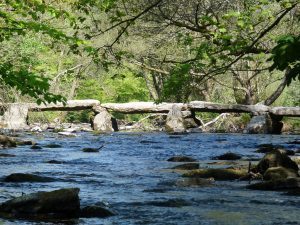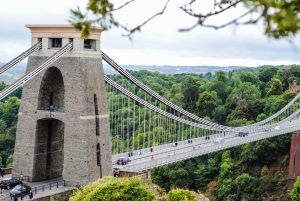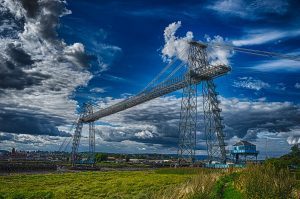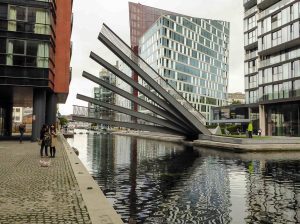The United Kingdom has a wealth of architectural heritage that can be visited for free, giving insight into the role architecture plays in our history, culture and day to day lives. Ronald Yee, Lecturer in Kent’s School of Architecture and Planning has revealed the five UK bridges worth visiting, saying:
‘During the industrial revolution Britain, was at the forefront of bridge innovation, created a rich bridge heritage which features many world firsts. Here are 5 landmark bridges in the UK worth visiting for free.
- Tintagel Castle Footbridge, Cornwall
- Tarr Steps, Exmoor
- Clifton Suspension Bridge, Bristol
- Newport Transporter Bridge, South Wales
- Paddington Basin Footbridges, London
- Tintagel Castle Footbridge
‘Cornwall’s Tintagel Castle is long associated with legend of King Arthur and Tristan and Isolde. Once connected to the mainland by a long collapsed land-bridge, the access point gave the castle its name, the Cornish Din Tagell meaning “the fortress of narrow entrance”.
‘The 72m Tintagel Castle Footbridge tracing the lines of the original land-link was designed by Belgian engineer Ney & Partners and British architect William Matthews Associates.
‘The footbridge comprises of two independent cantilevers reaching out and almost touching in the middle with a poetic gap between the two. The bridges’ cantilevered silhouette is a marriage between a stressed ribbon and an arch with stainless steel balustrades so fine that they disappear against the sky, when viewed from the surrounding cliff tops.

- Tarr Steps
‘Referred to as the “Devil’s Bridge” in Lorna Doone, Tarr Steps in Exmoor, is a seventeen-span clapper bridge that is possibly up to three thousand years old. It the largest example of its type in Britain with a combination of twenty three clappers resting on dry stone piers with a total length of 55m and a width of approximately 1.5m and crosses the River Exe at a height of 1m above normal water level.
‘Its distinguishing features include the raked stones positioned on the upstream side of the supports to divert the water flow and protect from floating debris, and on the downstream side as reinforcement. Despite this, slabs have been washed away during floods and the bridge has been repaired several times. To facilitate this the slabs are now all numbered!

- Clifton Suspension Bridge
‘The distinctive profile of the Clifton Suspension Bridge spanning the Avon Gorge is a symbol of Bristol & British Engineering. Conceived by Isambard Kingdom Brunel, its construction was dogged by interruptions and took 33 years to build. It was completed five years after Brunel’s death to a modified design in the spirit of the original by William Henry Barlow & Sir John Hawkshaw.
‘Shaped like cenotaphs, both Egyptian style towers taper towards the top to exaggerate their height and have openings on the centreline (to let traffic through). However the Clifton tower is taller (27.1m) and has square edges with relieving slits on its sides, whereas the Leigh Wood tower is 26.2m, with chamfered edges and no side slits. Furthermore, the arch soffit of the Clifton tower is visually more rounded than the arch soffit of the Leigh Wood tower. Brunel’s reasons why are not documented but given his reputation for detail, these differences must be deliberate. To further mystify us, the cornice of the Leigh Wood tower bares the Latin inscription SUSPENSA VIX VIA FIT (a suspended way made with difficulty).
‘Although designed for horse-drawn traffic, the bridge still copes with today’s traffic.

- Newport Transporter Bridge, South Wales
‘Designed by French engineer Ferdinand Arnodin, the Newport Transporter Bridgetraverses the River Usk in South Wales. A transporter bridge was chosen for this location because the Usk has an extreme tidal range ruling out ferry use at low tide and as the area is low lying, a conventional bridge would require very long approaches to achieve the required navigation clearance. The bridges’ structure is a hybrid suspension/cable-stay arrangement in principle. Four open lattice-framed legs, elliptical in elevation, form the “towers”. A pair of latticed running booms connected and braced to each other is the “deck”, supported by a combination of suspension and stay cables that pass over tower top saddles and are anchored into the ground behind.
‘Opened in 1906 it carries vehicles and pedestrians across the river on a steel and timber gondola suspended by 30 steel ropes under a trolley that travels back and forth along the boom, propelled by a continuous wire rope wound onto drums driven by electric motors.
Newport Transporter Bridge is now a Grade 1 listed structure.

- Paddington Basin Footbridges, West London
‘The Merchant Square Footbridge is also known as the Fan Bridge, spans 20m over the eastern end of the Paddington Basin. Designed by Knight Architects and engineer ATK II with Eadon Consulting, the 3m wide bridge consists of five ‘fingers’ each with sculpturally shaped counterweights, hinged at the north end and raised using hydraulic jacks. In operation the fingers lift in concert rather like a traditional Japanese fan, transforming its function from utility to kinetic sculpture. Once open the bridge’s distinctive silhouette is particularly striking when viewed from the aptly named Sunset Terrance.
‘The unique Rolling Bridge has several segments that roll or curl back into a cylinder. Conceived by Heatherwick Studio and engineered by Tony Hunt Associates, the bridge spans a small turning inlet off the main basin. Taking inspiration from the curling tails of Jurassic Park’s animatronics, Heatherwick employed hydraulic technology refined by the special effects industry to develop a bridge that rolls up until its ends join to make a compact octagon.
‘Completed in 2004, the 12m bridge is made up of eight triangular segments hinged at the base and connected at the top by articulated struts. The structure is only fixed to one bank and spends most of its time either fully open or closed but can be seen moving at midday on Wednesdays & Fridays.’

Ronald Yee is a Lecturer in the University of Kent’s School of Architecture and Planning. He is a chartered bridge architect with nearly forty years’ experience of bridging that began as an officer cadet with the Royal Engineers and is Principle of Yee Associates.
Ronald was the architect for a number of major bridges including Bhumibol Bridges in Thailand, Pont Vasco da Gama in Portugal, and the Rose Fitzgerald Kennedy Bridge in Ireland.
Ronald’s latest book is ‘The Architecture of British Bridges‘ (The Crowood Press, 2021).

